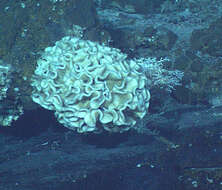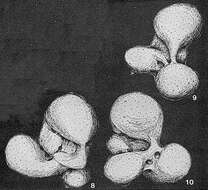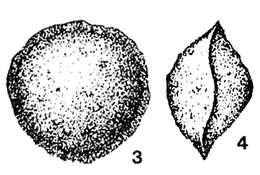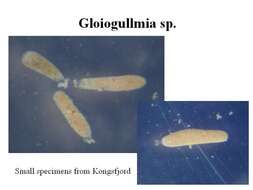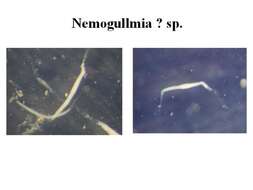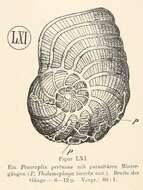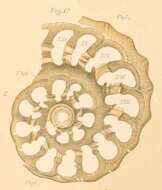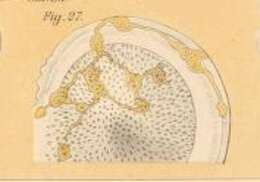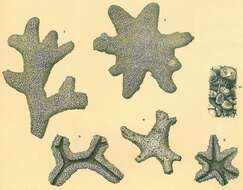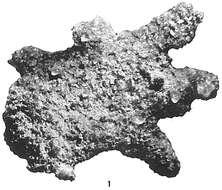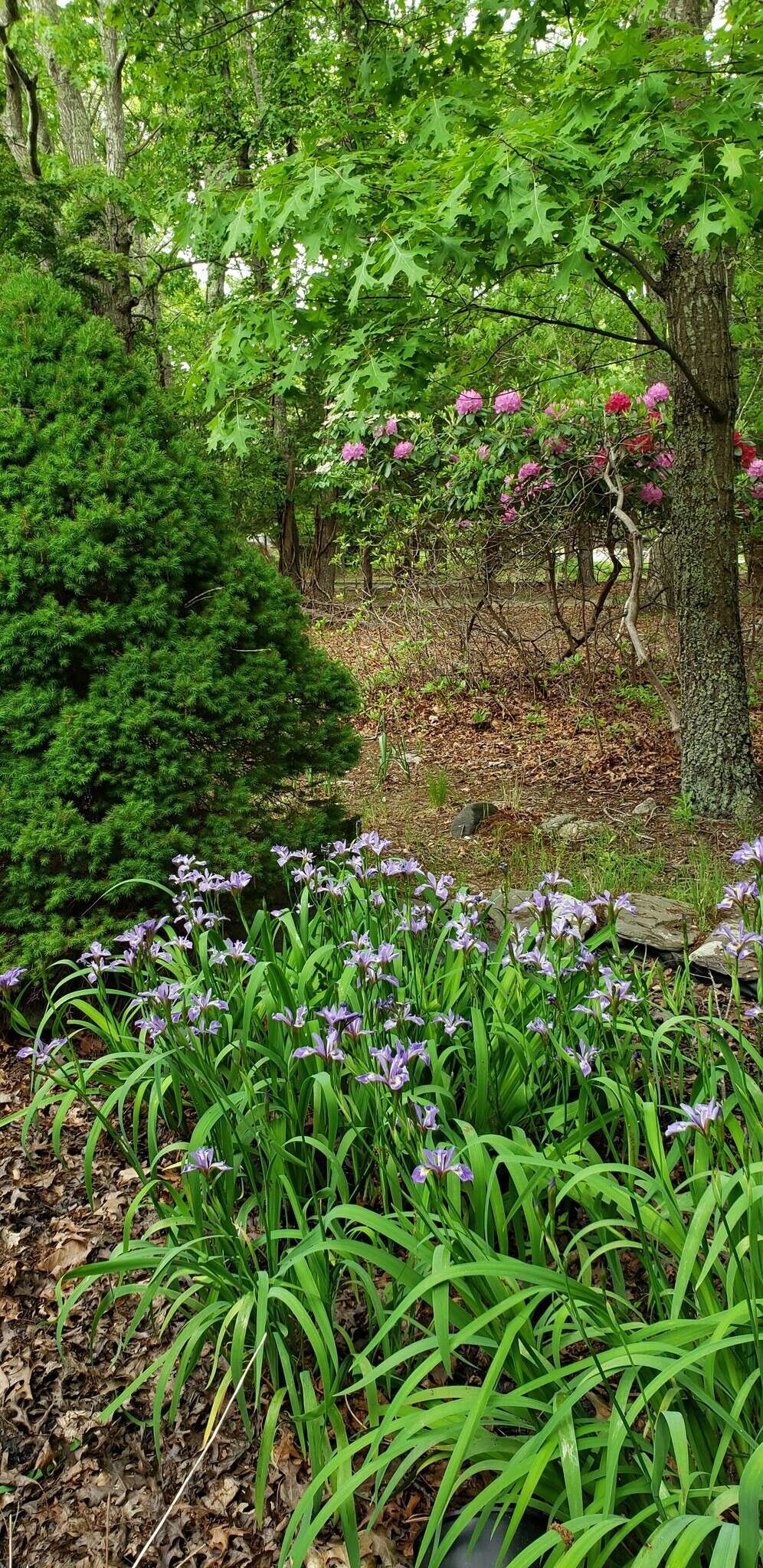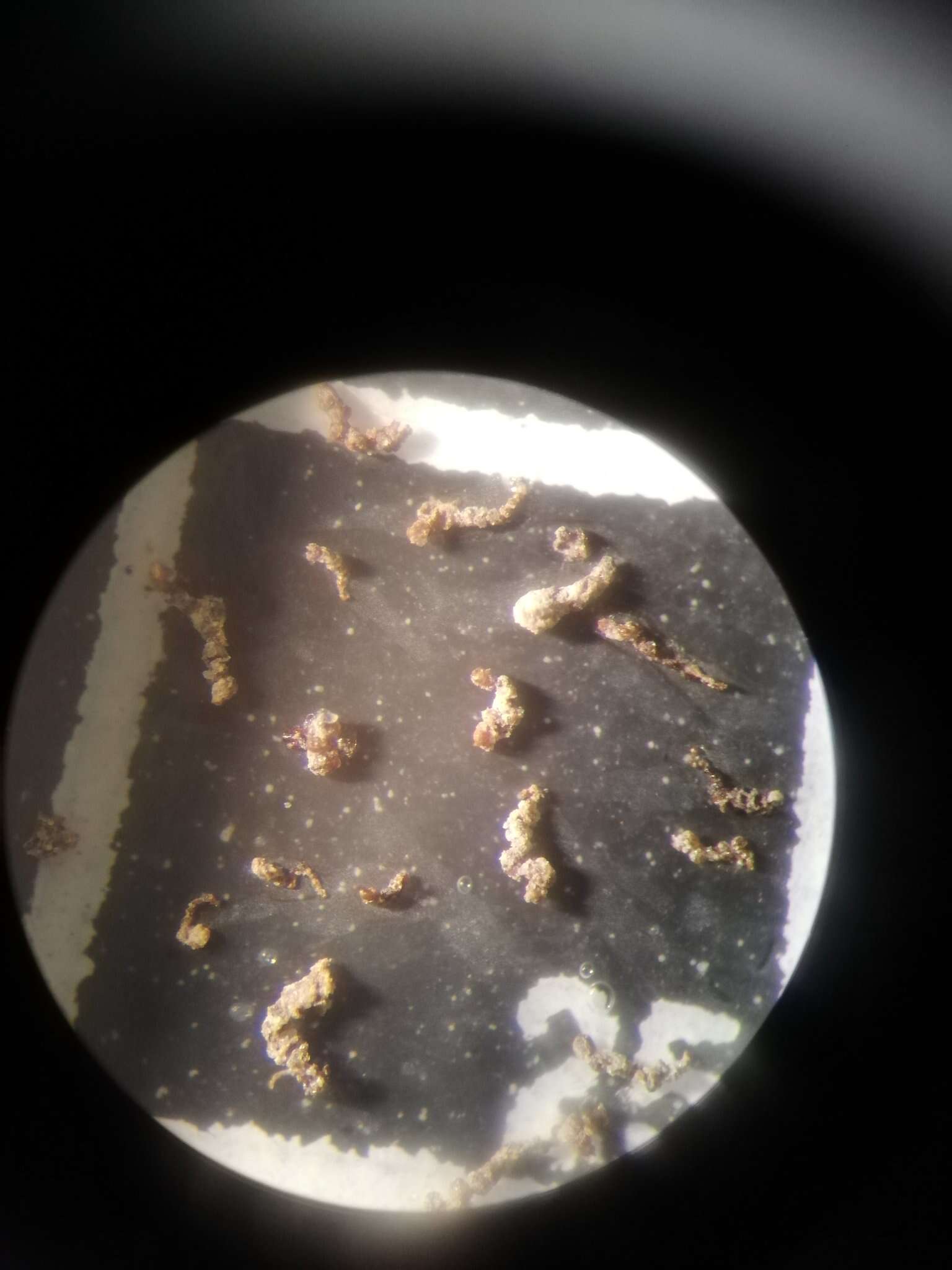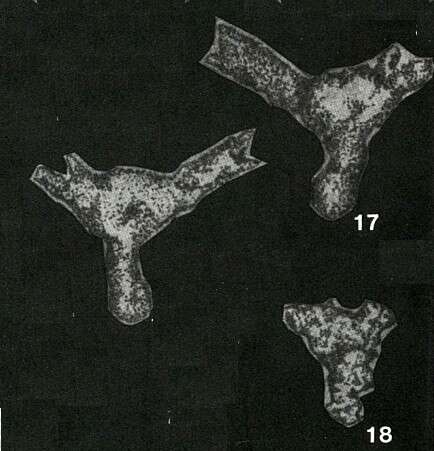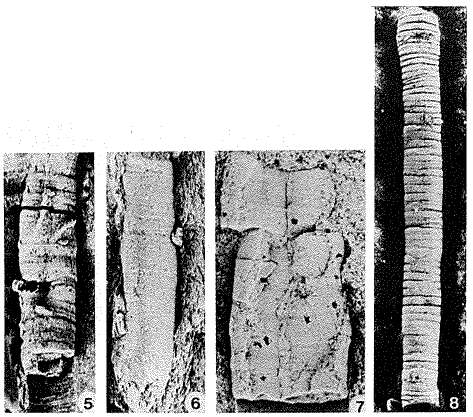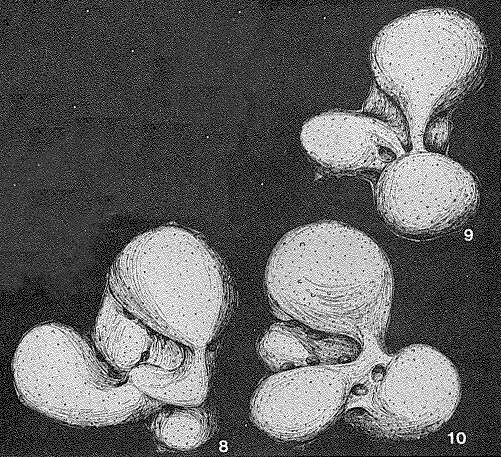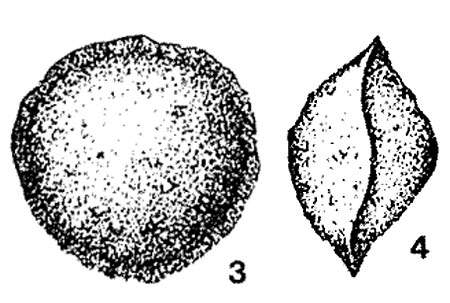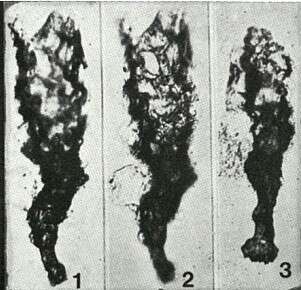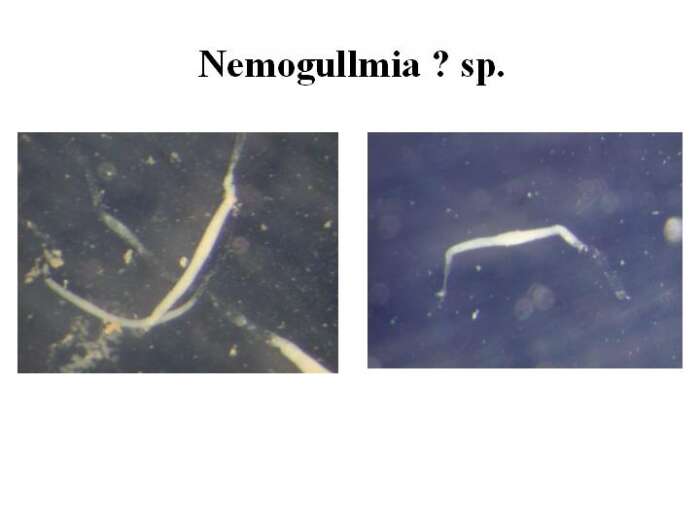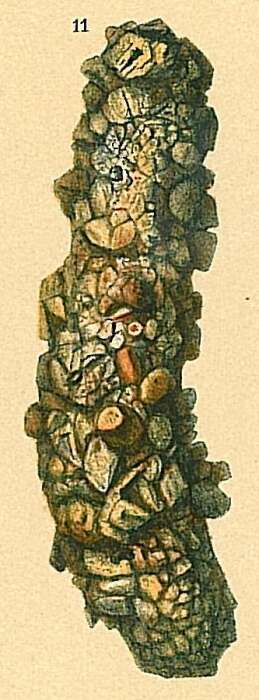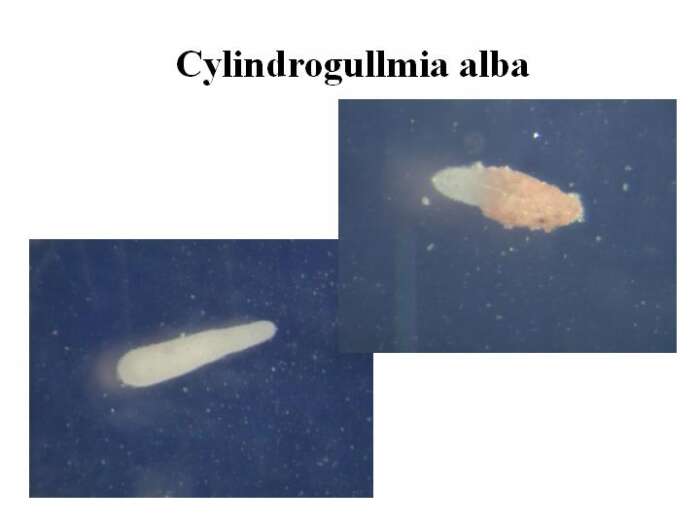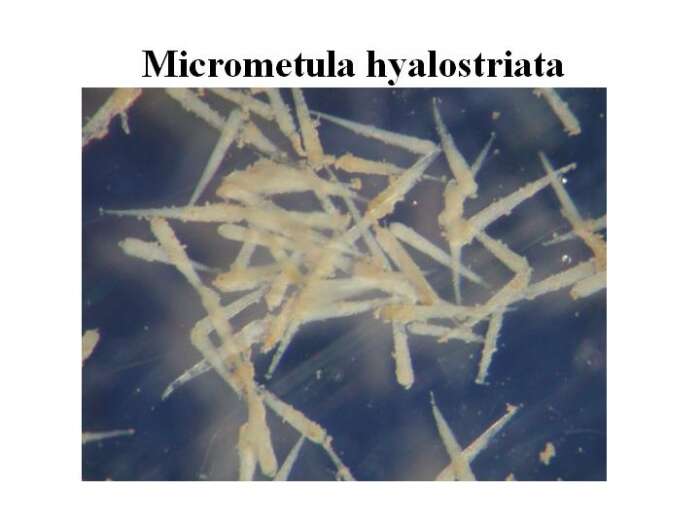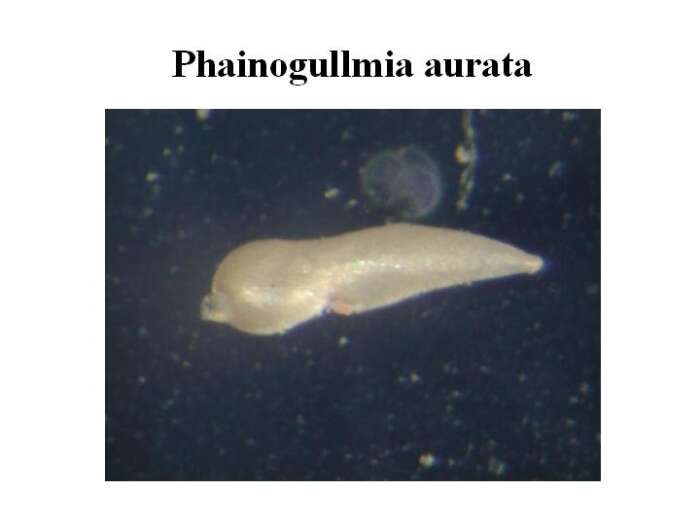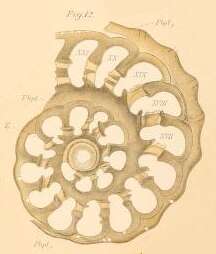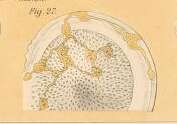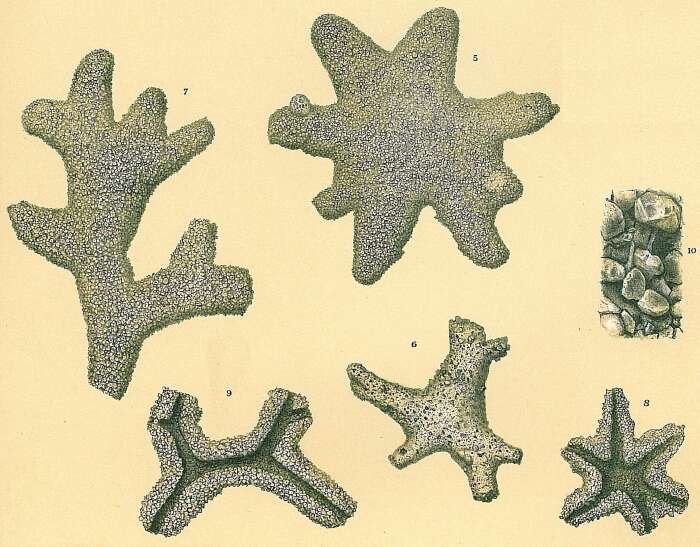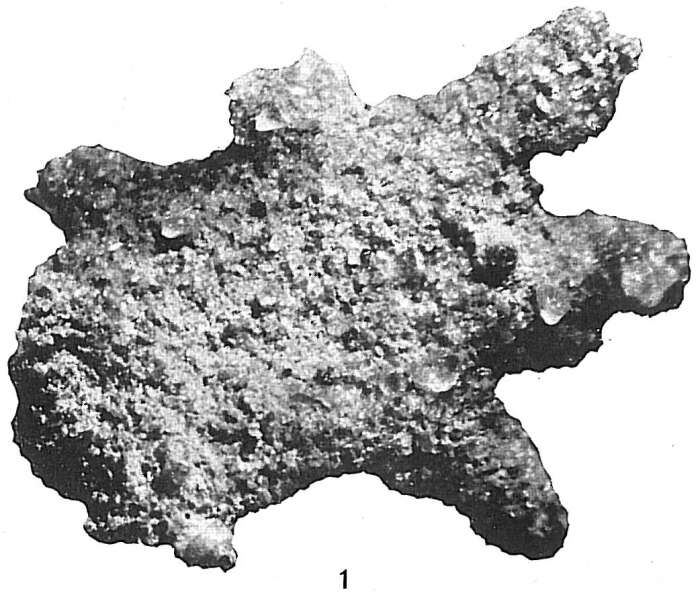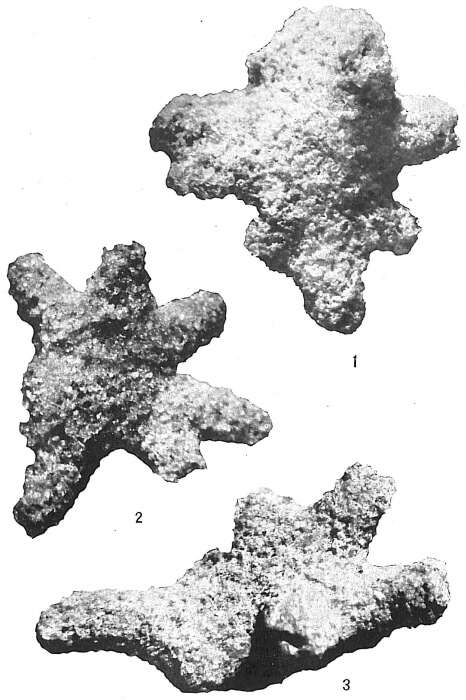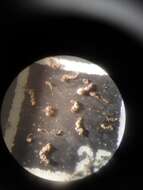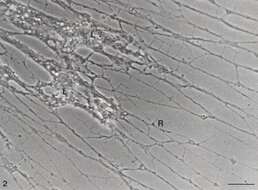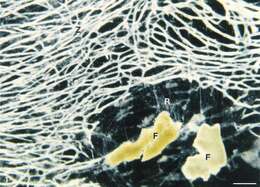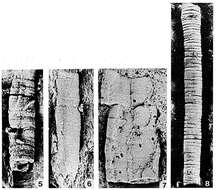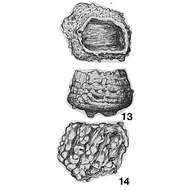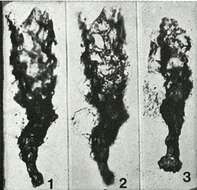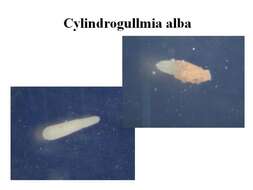-
-
-
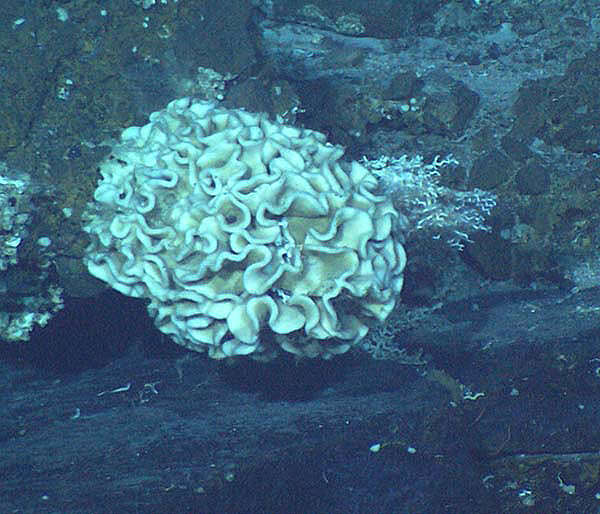
Description: Deutsch: Xenophyophore im Lost City Hydrothermal Field, 30°N auf dem Mittelatlantischen RückenEnglish: The image may be one of a large 20-cm wide
Xenophyophore. Xenophyophores are single cell Eukaryotes called protists. As benthic particulate feeders, xenophyophores normally sift through the sediments on the sea floor and excrete a slimy substance; in locations with a dense population of xenophyophores, such as at the bottoms of oceanic trenches, this slime may cover large areas. Local population densities may be as high as 2,000 individuals per 100 square meters. Image courtesy of IFE, URI-JAO, Lost City science party, and NOAA. Date: 2005. Source:
http://oceanexplorer.noaa.gov/explorations/05lostcity/logs/july27/media/xeno2.html. Author: NOAA. Permission(
Reusing this file): (
http://oceanexplorer.noaa.gov/backmatter/contactus.html, Punkt 5: "Unless otherwise noted (copyrighted material for example), information presented on this World Wide Web site is considered public information and may be distributed freely."). Other versions:
.
-
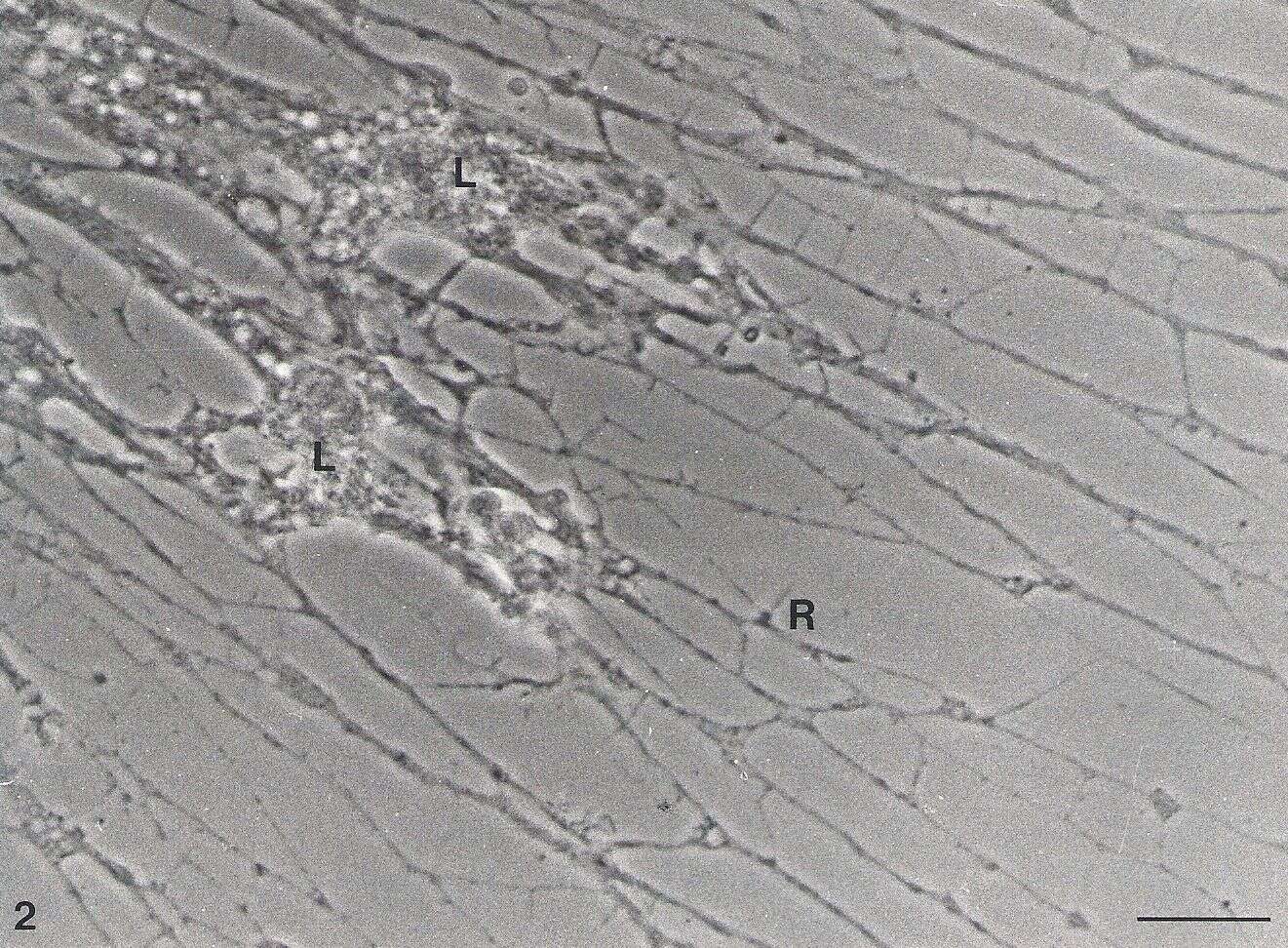
Summary.mw-parser-output table.commons-file-information-table,.mw-parser-output.fileinfotpl-type-information{border:1px solid #a2a9b1;background-color:#f8f9fa;padding:5px;font-size:95%;border-spacing:2px;box-sizing:border-box;margin:0;width:100%}.mw-parser-output table.commons-file-information-table>tbody>tr,.mw-parser-output.fileinfotpl-type-information>tbody>tr{vertical-align:top}.mw-parser-output table.commons-file-information-table>tbody>tr>td,.mw-parser-output table.commons-file-information-table>tbody>tr>th,.mw-parser-output.fileinfotpl-type-information>tbody>tr>td,.mw-parser-output.fileinfotpl-type-information>tbody>tr>th{padding:4px}.mw-parser-output.fileinfo-paramfield{background:#ccf;text-align:right;padding-right:0.4em;width:15%;font-weight:bold}.mw-parser-output.commons-file-information-table+table.commons-file-information-table,.mw-parser-output.commons-file-information-table+div.commons-file-information-table>table{border-top:0;padding-top:0;margin-top:-8px}@media only screen and (max-width:719px){.mw-parser-output table.commons-file-information-table,.mw-parser-output.commons-file-information-table.fileinfotpl-type-information{border-spacing:0;padding:0;word-break:break-word;width:100%!important}.mw-parser-output.commons-file-information-table>tbody,.mw-parser-output.fileinfotpl-type-information>tbody{display:block}.mw-parser-output.commons-file-information-table>tbody>tr>td,.mw-parser-output.commons-file-information-table>tbody>tr>th,.mw-parser-output.fileinfotpl-type-information>tbody>tr>td,.mw-parser-output.fileinfotpl-type-information>tbody>tr>th{padding:0.2em 0.4em;text-align:left;text-align:start}.mw-parser-output.commons-file-information-table>tbody>tr,.mw-parser-output.fileinfotpl-type-information>tbody>tr{display:flex;flex-direction:column}.mw-parser-output.commons-file-information-table+table.commons-file-information-table,.mw-parser-output.commons-file-information-table+div.commons-file-information-table>table{margin-top:-1px}.mw-parser-output.fileinfo-paramfield{box-sizing:border-box;flex:1 0 100%;width:100%}} Description: English: Small section of the Reticulopodial Network of Reticulomyxa filosa: Fine reticulopods alter with small lammellipodial sections. (Phase contrast micropgraph; bar = 50 micrometers). Date: 1997. Source: Own work. Author:
Dr. Ralf Schulz.
-
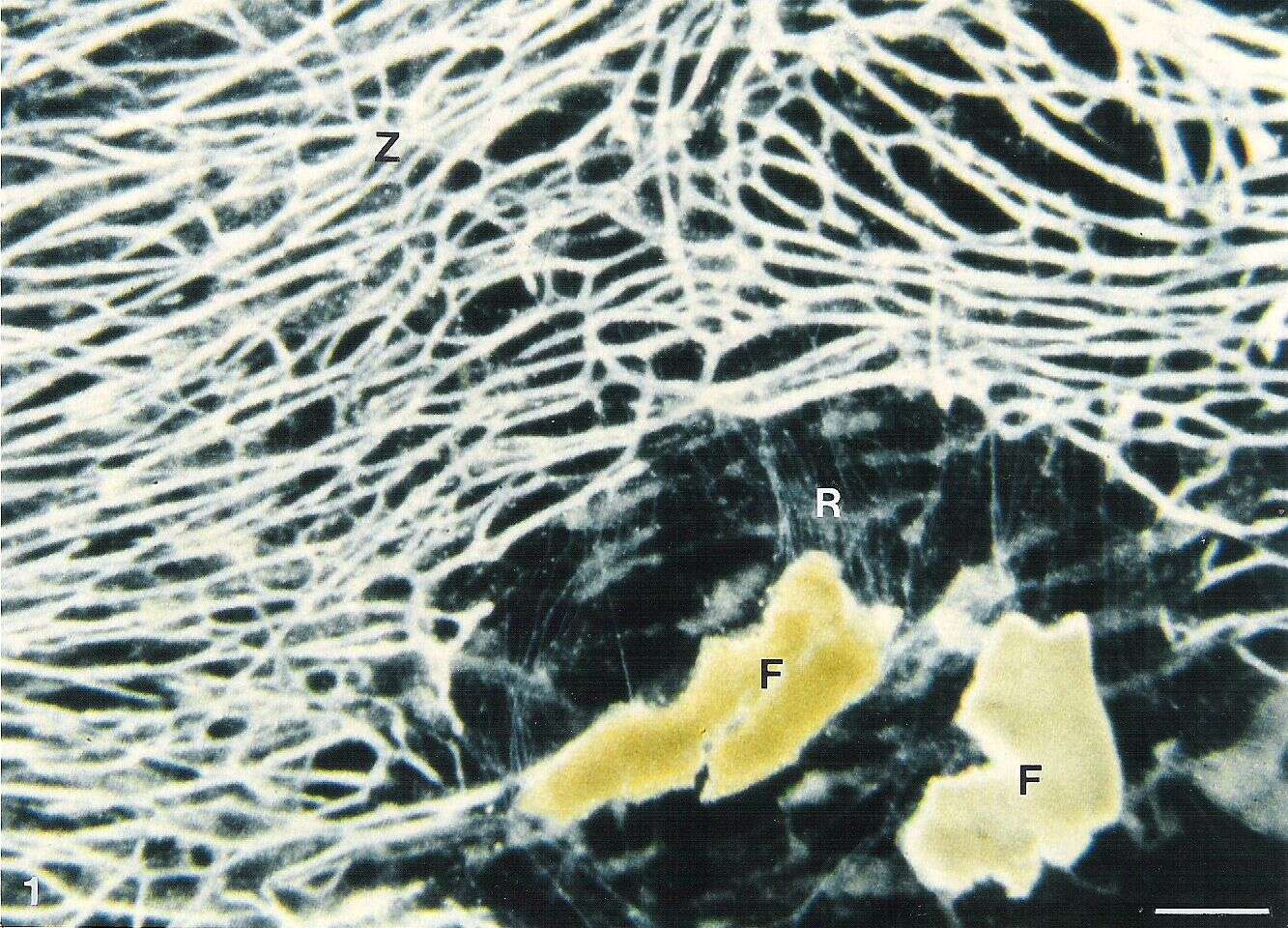
Summary.mw-parser-output table.commons-file-information-table,.mw-parser-output.fileinfotpl-type-information{border:1px solid #a2a9b1;background-color:#f8f9fa;padding:5px;font-size:95%;border-spacing:2px;box-sizing:border-box;margin:0;width:100%}.mw-parser-output table.commons-file-information-table>tbody>tr,.mw-parser-output.fileinfotpl-type-information>tbody>tr{vertical-align:top}.mw-parser-output table.commons-file-information-table>tbody>tr>td,.mw-parser-output table.commons-file-information-table>tbody>tr>th,.mw-parser-output.fileinfotpl-type-information>tbody>tr>td,.mw-parser-output.fileinfotpl-type-information>tbody>tr>th{padding:4px}.mw-parser-output.fileinfo-paramfield{background:#ccf;text-align:right;padding-right:0.4em;width:15%;font-weight:bold}.mw-parser-output.commons-file-information-table+table.commons-file-information-table,.mw-parser-output.commons-file-information-table+div.commons-file-information-table>table{border-top:0;padding-top:0;margin-top:-8px}@media only screen and (max-width:719px){.mw-parser-output table.commons-file-information-table,.mw-parser-output.commons-file-information-table.fileinfotpl-type-information{border-spacing:0;padding:0;word-break:break-word;width:100%!important}.mw-parser-output.commons-file-information-table>tbody,.mw-parser-output.fileinfotpl-type-information>tbody{display:block}.mw-parser-output.commons-file-information-table>tbody>tr>td,.mw-parser-output.commons-file-information-table>tbody>tr>th,.mw-parser-output.fileinfotpl-type-information>tbody>tr>td,.mw-parser-output.fileinfotpl-type-information>tbody>tr>th{padding:0.2em 0.4em;text-align:left;text-align:start}.mw-parser-output.commons-file-information-table>tbody>tr,.mw-parser-output.fileinfotpl-type-information>tbody>tr{display:flex;flex-direction:column}.mw-parser-output.commons-file-information-table+table.commons-file-information-table,.mw-parser-output.commons-file-information-table+div.commons-file-information-table>table{margin-top:-1px}.mw-parser-output.fileinfo-paramfield{box-sizing:border-box;flex:1 0 100%;width:100%}} Description: English: This is a darkfield macroscopic foto of the cell body (Z) of Reticulomyxa filosa. In the lower right of the picture you see some food particles (F) (wheat germ) surrounded by the fine stands of the Reticulopodial Network (R). Date: 1997. Source: Own work. Author:
Dr. Ralf Schulz.
-
Loeblich, A. R., Tappan, H. N., 1987: Foraminiferal genera and their classification. Van Nostrand, Reinhold Co. New York 1728 pp. Plate 32, Figs. 16-18: U. Silurian (Ludlovian), Ural Mountains, Russia. 16, 17, Holotype, from opposite sides, x 60; 18, paratype, x 60 (from Chernykh, 1969). courtesy of Michael Hesemann https://foraminifera.eu
-
Loeblich, A. R., Tappan, H. N., 1987: Foraminiferal genera and their classification. Van Nostrand, Reinhold Co. New York 1728 pp. Plate 14, Figs. 5-8: L. Cambrian, Norway. 5, x 5; 6, 7, x 11; 8, x 9 (from Foyn and Glaessner, 1979).
-
Loeblich, A. R., Tappan, H. N., 1987: Foraminiferal genera and their classification. Van Nostrand, Reinhold Co. New York 1728 pp. Plate 19, Figs. 8-10: U. Ordovician or L. Silurian, Austria. Holotype, in three views, x 97 (from Kristan-Tollmann, 1971).
-
Loeblich, A. R., Tappan, H. N., 1987: Foraminiferal genera and their classification. Van Nostrand, Reinhold Co. New York 1728 pp. Plate 18, Figs. 3-4: U. Cretaceous (Campanian-Santonian), Kazakhstan. Side and edge views of holotype, x 50 (from Suleymanov, 1969). courtesy of Michael Hesemann https://foraminifera.eu
-
Loeblich, A. R., Tappan, H. N., 1987: Foraminiferal genera and their classification. Van Nostrand, Reinhold Co. New York 1728 pp. Plate 24, Figs. 12-14: U . Silurian (Ludlovian), Austria. Top, edge, and base of holotype, x 76 (from Kristan-Tollmann, 1971). courtesy of Michael Hesemann https://foraminifera.eu
-
Loeblich, A. R., Tappan, H. N., 1987: Foraminiferal genera and their classification. Van Nostrand, Reinhold Co. New York 1728 pp. Plate 32, Figs. 1-3: M. Silurian (Wenlockian-L. Ludlovian), Baltic area. 1, 2, Holotype, at two Ievels of focus, x 130; 3, smaller individual with distinct early portion, x 130 (from Eisenack, 1969). courtesy of Michael Hesemann https://foraminifera.eu
-
Specimens were isolated from surface sediments samples collected in Kongsfjorden, Isfjorden and Adventfjorden during the cruise of r/v « Oceania » between 22 July and 2 August 2004. The sediment samples were sieved at 500 um and 125 um sized meshes, and living specimens were picked under dissecting microscope on board. The specimens were photographed, measured and fixed for further DNA extraction. Source: http://www.iopan.gda.pl/projects/biodaff/EMBS-06.html
-
Specimens were isolated from surface sediments samples collected in Kongsfjorden, Isfjorden and Adventfjorden during the cruise of r/v « Oceania » between 22 July and 2 August 2004. The sediment samples were sieved at 500 um and 125 um sized meshes, and living specimens were picked under dissecting microscope on board. The specimens were photographed, measured and fixed for further DNA extraction. Source: http://www.iopan.gda.pl/projects/biodaff/EMBS-06.html
-
Technitella sp.nov. sensu Jones, R.W. 1994. The Challenger Foraminifera. Image source: Brady, H.B. (1884) Pl. 25
-
Specimens were isolated from surface sediments samples collected in Kongsfjorden, Isfjorden and Adventfjorden during the cruise of r/v « Oceania » between 22 July and 2 August 2004. The sediment samples were sieved at 500 um and 125 um sized meshes, and living specimens were picked under dissecting microscope on board. The specimens were photographed, measured and fixed for further DNA extraction. Source: http://www.iopan.gda.pl/projects/biodaff/EMBS-06.html
-
Specimens were isolated from surface sediments samples collected in Kongsfjorden, Isfjorden and Adventfjorden during the cruise of r/v « Oceania » between 22 July and 2 August 2004. The sediment samples were sieved at 500 um and 125 um sized meshes, and living specimens were picked under dissecting microscope on board. The specimens were photographed, measured and fixed for further DNA extraction. Source: http://www.iopan.gda.pl/projects/biodaff/EMBS-06.html
-
Specimens were isolated from surface sediments samples collected in Kongsfjorden, Isfjorden and Adventfjorden during the cruise of r/v « Oceania » between 22 July and 2 August 2004. The sediment samples were sieved at 500 um and 125 um sized meshes, and living specimens were picked under dissecting microscope on board. The specimens were photographed, measured and fixed for further DNA extraction. Source: http://www.iopan.gda.pl/projects/biodaff/EMBS-06.html
-
Specimens were isolated from surface sediments samples collected in Kongsfjorden, Isfjorden and Adventfjorden during the cruise of r/v « Oceania » between 22 July and 2 August 2004. The sediment samples were sieved at 500 um and 125 um sized meshes, and living specimens were picked under dissecting microscope on board. The specimens were photographed, measured and fixed for further DNA extraction. Source: http://www.iopan.gda.pl/projects/biodaff/EMBS-06.html
-
Rhumbler L. (1911 (cover 1909)). Die Foraminiferen (Talamophoren) der Plankton-Expedition. Zugleich Entwurf eines natürlichen Systems der Foraminiferen auf Grund selektionistischer und mechanisch-physiologischer Faktoren. Ergebnisse der Plankton-Expedition der Humboldt-Stiftung. vol. 3 L.c.: 1-331., available online at (http://www.biodiversitylibrary.org/item/18706#page/7/) page(s): p. 229 tf. 61, pl. 12 fig. 12
-
Rhumbler L. (1911 (cover 1909)). Die Foraminiferen (Talamophoren) der Plankton-Expedition. Zugleich Entwurf eines natürlichen Systems der Foraminiferen auf Grund selektionistischer und mechanisch-physiologischer Faktoren. Ergebnisse der Plankton-Expedition der Humboldt-Stiftung. vol. 3 L.c.: 1-331., available online at (http://www.biodiversitylibrary.org/item/18706#page/7/) page(s): p. 229 tf. 61, pl. 12 fig. 12
-
Rhumbler L. (1911 (cover 1909)). Die Foraminiferen (Talamophoren) der Plankton-Expedition. Zugleich Entwurf eines natürlichen Systems der Foraminiferen auf Grund selektionistischer und mechanisch-physiologischer Faktoren. Ergebnisse der Plankton-Expedition der Humboldt-Stiftung. vol. 3 L.c.: 1-331., available online at (http://www.biodiversitylibrary.org/item/18706#page/7/) page(s): pp. 228-231 pl. 39 fig. 27
-
Astrorhiza arenaria sensu Jones, R.W. 1994. The Challenger Foraminifera. Image source: Brady, H.B. (1884) Pl. 19
-
Image source: Cushman, J.A. 1918. The Foraminifera of the Atlantic Ocean. Part I. Astrorhizidae. Bull. U.S. Natl. Mus. 104.
-
Image source: Cushman, J.A. 1918. The Foraminifera of the Atlantic Ocean. Part I. Astrorhizidae. Bull. U.S. Natl. Mus. 104.



